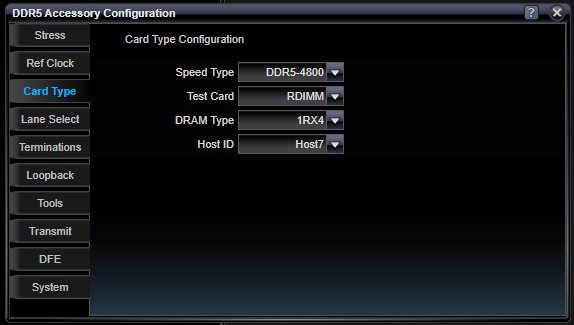DDR5 Card Type Configuration
The DDR5 test application depends on the DUT making bit decisions on its receiver and looping those decisions back to our Pattern Generator for measurement. This is a test mode of various DDR5 chips, and this test mode must be configured and enabled to be able to proceed with measurements.
Enabling this test mode requires extra information about the test condition to be able to correctly loopback the right signal. Make these settings here and in the following Loopback Configuration menu.

|
Speed Type |
|
|
DDR5-3200 / |
DDR5 devices can operate at a range of speeds. The expected speed to be used for the current test is set here so the DLL mode registers inside the receiver can be set. |
|
Test Card |
|
|
RDIMM / LRDIMM / COMBO |
The DDR5 Accessory supports testing either RDIMMs, LRDIMMs, or COMBO cards. On these types of cards |
|
DRAM Type |
|
|
1RX4 / 1RX8 / 2RX4 / 2RX8 |
There are two sets of 32 data lanes and chip select lines on the edge connector of a DDR5 DIMM. These lanes and selects can be assigned to different DRAM chips according to various configurations. The DDR5 Accessory needs to know this configuration mode so it knows which chips to interact with when programming test modes over the I2C bus. |
|
Host ID |
|
|
Host0 - Host7 |
To support multiple DIMM slots, the DDR5 specification supports addressing a few different slots by changing the HostIDs (these are changed on test boards by changing resistor values). Most test applications using JEDEC CTC2 boards leave this HostID set to 7. |
See Also